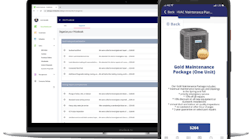Success has cursed the HVAC industry. People need heating and cooling to live comfortably, and in some parts of the country, it's required just to live. For several generations, new home construction has provided heating and air-conditioning contractors with sales and eventually the service and replacement of what they installed. In hindsight it was easy; all one had to do was to install, service and replace equipment, and a business would succeed. Our industry didn't have to be efficient, it just had to function. The recent round of government-sponsored tax credit incentives further falsely extended this scourge. Being mediocre has been good enough, and that is our curse.
Everything has changed. Today, all businesses face the challenge of delivering the highest level of customer satisfaction and doing so with the greatest efficiency. Demanding customers will tolerate nothing less and failure to do so will not produce a sustainable profit. All of this has many implications for the HVAC distributor and contractor.
The most profitable contractors, the ones all distributors fight over, have already moved ahead of others by creating efficient processes for all departments and managing them carefully to ensure maximum profitability. This is easier to say than to do. Defining these processes, documenting them, training co-workers to perform properly, measuring the results and managing all of this to sustain results require planning, determination and a willingness to stick to the plan. Wouldn't it be nice if there were a proven template for contractors to follow?
So where does operating in the cloud come into play, and where is the opportunity for the distributor? The contractor who runs his or her business through an online software product automatically steps into the area of proven best practices of the most successful contractors. Not only will the software provide an integrated solution to managing customer contact information, the service department, sales and installation, it will do this without the overhead expense of data entry from paperwork that is often incomplete, illegible and late. Imagine inputting data once, at the time and source that you create the data, and have it become a permanent record that migrates to all departments. Imagine the contractor principal being able to retrieve reports in real-time from any place, using any computer, tablet or smartphone. Imagine how efficient all of this would be … and the impact to the bottom-line for the contractor.
Page 2 of 3
How can the distributor participate in this and capitalize on this? The contractor's ultimate measurement of his distributor's value is reducible to a single word: profit. The distributor's relationship with the contractor must be a more profitable one or the contractor will change to another distributor. There are three ways for the contactor to become more profitable, 1) increase sales, 2) increase profit margins and 3) lower costs.
For now, let's look at how an online software system can improve sales. Here's what should be happening:
-
There is a well-managed, consistent marketing effort to gather as much repeat business with existing customers (clients) as possible. This includes direct mail, opt-in email campaigns and technician-generated replacement sales leads.
-
Permanently recording all new leads into a database and tracking them.
-
Instantly scheduling all leads and notifying the salesperson immediately.
-
In seconds, a confirming email is sent to the customer with the salesperson's photo and bio, information about the company, a summary of what to expect on the call and links to related information.
-
The salesperson is prepared for the call with a customer survey form, system design form, load calculation tool, annual utility savings estimating tool, cook-book pricing, three-choice-proposal worksheet, financing program information, job photos and testimonials to share, a company presentation book and final contract.
-
After the customer survey and system evaluation, the salesperson sits at the kitchen table to run the load, estimate the savings, then prepare and price the three system choices. During this time, the customers look at the job photo-testimonial information.
-
The salesperson then presents the company with the three system choices, asks for the sale, handles any objections, finalizes the contract and the financing, schedules the installation right then, shakes hands and leaves. And all this can happen in the time allotted by the homeowner.
-
With an online software system, the office knows you sold the job as soon as the salesperson clicks on the Job Sold button. You have already scheduled the installation because the salesperson has accessed the schedule online. The office can then print the work order, check inventory for what you need and order what is not in stock.
Page 3 of 3
Perfect. Wouldn't your contractors want every sales call to be run this way? Unless you have structured the company with the online software and tools and have trained the salesperson to use it, none of this can ever happen.
You can bring this level of professionalism to your contractors. You would be helping them in a unique way, and doubtlessly they would appreciate it. That's nice, but you can't take “appreciation” to the bank. Here's how you can profit from this approach. Imagine if your contractor had only your product information in his data, with your products automatically configured into the salesperson's proposals, and the software defaulted to generate purchase orders to you. To keep this “cloud relationship” working, you would automatically update their data with any product or price changes, keeping them instantly current, eliminating product change and pricing change confusion, errors and lost margins. (As for their service department, imagine you can keep their service parts requirements current in their system and even replenish their inventory based on their usage immediately after each service call.) How much would all that be worth to your contractors? A lot. You can simultaneously help your customers increase their top line and lower their overhead, putting valuable points on the bottom line. That, my friends, is the best way to earn your contractor's business.
Tom Piscitelli is the founder of TRUST® Training and Consulting, www.sellingtrust.com.
Mark Sims is president of Chameleon Management Solutions, Inc. and the creator of TRUST PRO® online www.trustproonline.com.
WHAT IS CLOUD-BASED COMPUTING?
Cloud computing is a general term for any software that provides hosted services over the Internet. Many of us have experience with using cloud-based data backup storage with third-party providers such as Google, Microsoft, Dropbox, Amazon, Mozy and others. This gives us peace of mind about losing valuable data as well as unlimited access from anywhere, anytime. In this article, we are talking about the Software as a System (SaaS) cloud model where the vendor supplies the hardware infrastructure and the software product and interacts with the user through a front-end portal. Because the service provider hosts both the application and the data, the end-user is free to use the service from anywhere, which, for a mobile industry like ours, has significant benefits.
The advantages of a cloud-based or SaaS-based system are many:
-
User device and location independence — access to the system from any device anywhere there is Internet access.
-
Lower cost — both initial investment and ongoing maintenance costs compared with conventional models are reduced due to cost sharing of the infrastructure and that it is user device independent (use the system on any computer, smartphone or tablet).
-
More reliable and secure — resources are maintained and automatically backed up in a professional, secure and staffed facility. These capabilities are not typically afforded to small businesses.
-
You own your data and can have it any time to give you peace of mind.





